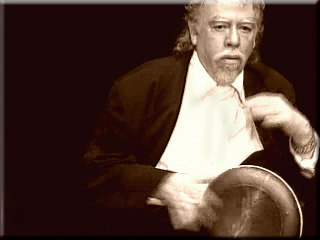| metric modes (iqâ'ât) & melodic modes (maqâmât) |
|
 Video demonstration of the iqâ'ât by Vince Delgado |
 Video demonstration of the maqâmât by Ali Jihad Racy |
|
In the following
descriptions of some of the most popular iqâ'ât, dum denotes a low, resonant tone and
tak denotes a high, crisp tone. Click on the name of each mode to listen to an example |
Maqâmât are often understood in terms of scalar units such as tetrachords (sets of 4 notes), which constitute the nucleus of the expanded modes (usually spanning two octaves). The following are five representative maqâmât. Traditionally, Râst and Nahawand rest on C, while Bayyâti, Hijâz, and Sabâ rest on D. |
| Wahdah Wahid means "one" in Arabic and Wahdah has a single 'dum' at the beginning. The Wahdah is primarily just an initial accent with varying fills, and can exist in various lengths. e.g.: ( 1 ---- | ---- | ---- | ---- 1---- | ---- | ---- | ---- ) dum dum |
Râst Râst means "straight" or "right" in Persian. The Râst mode is similar to the major scale but with the 3rd and 7th degrees flattened by, roughly, a 1/4 tone. During descending, the 7th degree is usually fully flattened. (
|
| Masmûdi Masmûdi consists of two main variants. One is 4 beats long and has a lively character (Masmûdi Saghîr, which means small Masmûdi.) It is fairly common in dance music. The other variant is 8 beats long with a slow, more solemn character (Masmûdi Kabîr which means big Masmûdi.) The following is an example of the Masmûdi Kabîr: ( 1 ---- 2 ---- | ---- 4 ---- 5 ---- | ---- 7 ---- | ----) dum dum tak dum tak |
Nahawand Nahawand is similar to the harmonic minor scale during ascending and to the natural minor scale during descending:
|
| Samâ'i Thaqîl Samâ'i Thaqîl means "heavy Samâ'i" and is commonly heard in both Ottoman and Arab classical musics. It consists of a 10-beat pattern, usually transcribed as 10/8: (1 ---- | ---- | ---- 4 ---- | ---- 6 ---- 7 ---- 8 ---- | ---- | ----) dum tak dum dum tak |
Bayyâtî Bayyâti uses D as its tonic, with the 2nd and 6th degrees flattened by, roughly, a 1/4 tone. During descending, the 6th degree is usually fully flattened:
|
| Maqsûm Maqsûm is one of the most prevelant Arab rhythmic modes, typical of dance music. It consists of a 4-beat pattern, usually transcribed as 4/4. A simple version is: ( 1 ---- | ---- 2 ---- | ---- 3 ---- | ---- 4 ---- | ---- ) dum tak tak dum tak |
Hijâz Hijâz uses D as tonic. During descending, the 6th degree is usually fully flattened:
|
| Malfûf Malfûf is a fast rhythmic pattern, typical of popular and folk music. It is usually transcribed as 2/4 or 4/4 and may accompany lively dancing: ( 1 ---- | ---- 2 ---- | ---- 3 ---- | ---- 4 ---- | ---- ) dum tak tak |
Sabâ The word Sabâ refers to the easterly breeze and the mode is often associated with a feeling of sadness. Note that the mode does not include the octave interval:
|
| Metric & Melodic Modes |
